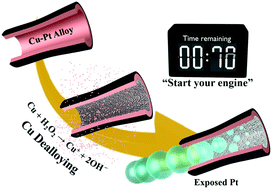Delayed ignition and propulsion of catalytic microrockets based on fuel-induced chemical dealloying of the inner alloy layer†
Abstract
The delayed ignition and propulsion of catalytic tubular microrockets based on fuel-induced chemical dealloying of an inner alloy layer is demonstrated. Such timed delay motor activation process relies on the preferential gradual corrosion of Cu from the inner Pt–Cu alloy layer by the peroxide fuel. The dealloying process exposes the catalytically active Pt surface to the chemical fuel, thus igniting the microrockets propulsion autonomously without external stimuli. The delayed motor activation relies solely on the intrinsic material properties of the micromotor and the surrounding solution. The motor activation time can thus be tailored by controlling the composition of the Cu–Pt alloy layer and the surrounding media, including the fuel and NaCl concentrations and local pH. Speed acceleration in a given fuel solution is also demonstrated and reflects the continuous exposure of the Pt surface. The versatile “blastoff” control of these chemical microrockets holds considerable promise for designing self-regulated chemically-powered nanomachines with a “built-in” activation mechanism for diverse tasks.


 Please wait while we load your content...
Please wait while we load your content...